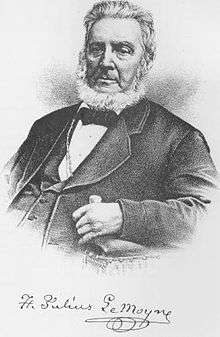LeMoyne–Owen College
Former names |
LeMoyne College Owen College |
|---|---|
| Motto | "Gubernatio. Opportunitas. Inclino." |
Motto in English | "Leadership. Opportunity. Change." |
| Type | Private, HBCU |
| Established |
1968 LeMoyne College - 1871 Owen College - 1947 |
| Affiliation | United Church of Christ |
| Endowment | $13.4 million (2015)[1] |
| President | Dr. Andrea Miller |
| Students | 945 |
| Location |
Memphis, TN, USA 35°07′18″N 90°02′06″W / 35.12175°N 90.03495°WCoordinates: 35°07′18″N 90°02′06″W / 35.12175°N 90.03495°W |
| Campus | Urban |
| Colors | Purple and Gold |
| Nickname | LOC |
| Mascot | The Magicians |
| Website | www.loc.edu |
LeMoyne–Owen College (LOC or simply "LeMoyne") is a fully accredited, four-year private historically black college located in Memphis, Tennessee, affiliated with the United Church of Christ. It resulted from the 1968 merger of historically black colleges and other schools established by northern Protestant missions during and after the American Civil War.
History
LeMoyne Normal and Commercial School was founded in 1862, when the American Missionary Association (AMA) sent Lucinda Humphrey to open an elementary school at Camp Shiloh (Tennessee) for free blacks and escaped slaves. This was one of more than ten schools founded by the AMA, an integrated organization led by black and white Congregational, Methodist and Presbyterian ministers.
The school was established soon after the occupation of Memphis by Federal troops during the Civil War; they were based at Camp Shiloh outside the city limits to the south. First known as Lincoln Chapel, the school relocated into Memphis proper in 1863 from south of the city. In 1866 it was destroyed during white race riots that broke out following the withdrawal of federal troops.

The school was rebuilt, and in 1867 it reopened with 150 students and six teachers. In 1870, Francis Julius LeMoyne (1798-1879), a Washington, Pennsylvania doctor, donated $20,000 to the American Missionary Association to build an elementary and secondary school for prospective teachers. LeMoyne, who was a notable abolitionist, traveled from his Pennsylvania home to visit the new school. He donated a clock for the school's tower. In 1871, the school opened in a new building at 284 Orleans Street and was named LeMoyne Normal and Commercial School.[2]
The Memphis yellow fever epidemic started in 1873 and took a toll on many school personnel.
Under the leadership of the third principal, Andrew J. Steele, the school enjoyed three decades of growth and development.[3]
In 1914 the school moved from Orleans Street to its present site on Walker Avenue. Steele Hall, the first building on the new campus, was erected that same year. LeMoyne became a junior college in 1924. After developing a four-year curriculum, it became a four-year college in 1930. The LeMoyne College was chartered by the State of Tennessee four years later. Steele Hall was listed on the National Register of Historic Places in 1979, and the core of the college's campus was listed on the National Register in 2005.
Owen College was established as a junior college in 1947, when the Tennessee Baptist Missionary and Educational Convention bought property for that purpose on Vance Avenue. After they developed the facility, S. A. Owen Junior College opened at that location in 1954.
LeMoyne–Owen College was formed through the 1968 merger of LeMoyne College and Owen College, both private, historically black, church-affiliated colleges.[4]
Historic district
|
LeMoyne College Historic District | |
  | |
| Location | Roughly bounded by Walker, Hollis Price, Crown and alley to rear of Sweeney Hall, Memphis, Tennessee |
|---|---|
| Coordinates | 35°07′15″N 90°02′05″W / 35.12083°N 90.03472°W |
| Area | 4 acres (1.6 ha) |
| Built | 1914 |
| Architect | George Awsumb; Tandy & Foster |
| Architectural style | Colonial Revival, Modernist |
| NRHP reference # | 05001215[5] |
| Added to NRHP | November 9, 2005 |
The LeMoyne College Historic District is a historic district which was listed on the National Register of Historic Places in 2005.[5] It includes four contributing buildings and the 1936 campus quadrangle as a contributing site. It is roughly bounded by Walker, Hollis Price, Crown and alley to rear of Sweeney Hall.[6]
It includes Steel Hall, built in 1914, the oldest and original building on this campus, which was designed by Tandy & Foster and is separately listed on the National Register.[7] It includes two Colonial Revival buildings, Brownlee and Sweeney halls, which were designed by George Awsumb along with the quadrangle in 1936. Sweeney Hall is named for Frank J. Sweeney, college president during 1929-1942, and originally served as the president's residence.[6]
It includes the three-story Modernist-style Hollis F. Price Library, built in 1963, designed by architects Gassner-Nathan-Browne, named for Dr. Hollis F. Price, college president during 1943-1970.[6]
Athletics

The college sponsors athletic teams that participate in the Division II level, in the Southern Intercollegiate Athletic Conference (SIAC) conference of the NCAA. The LeMoyne–Owen College Department of Athletics sponsors men's intercollegiate baseball, basketball, cross country, golf, and tennis along with women's intercollegiate softball, basketball, cross country, volleyball and tennis. The school's mascot is the Magicians.
In 1975, the LeMoyne–Owen College men's basketball team won the NCAA Men's Division III Basketball Championship.[8] the school was then a member of Division III level of the NCAA. Up to this day, LeMoyne-Owen has been the only HBCU to win a national championship at that level.
Dominique Worthen of LeMoyne–Owen College was the first player in SIAC history to win the SIAC Player of the Year award, earn a selection to the All Conference Team, and earn the SIAC Conference Championship MVP award, and an All Tournament First Team award, all in one week. Worthen of LeMoyne-Owen also won the 2015 PGA Minority Collegiate Championship.
Recent debt and accreditation issues
According to a 2007 AP article,[9] LeMoyne-Owen suffered from management and accreditation issues due to a lack of financial resources. The Southern Association of Colleges and Schools placed the college on probation for two years.
In August 2007, the City of Memphis ensured the college would open for the fall 2007 semester by pledging $3 million in taxpayer funds to be added to other substantial pledges from the United Negro College Fund, Cummins, radio host Tom Joyner and the United Church of Christ. The donation pledge, approved by the City Council, aroused controversy. City councilmembers defended their actions as contributing to the city and its residents.
The college's president Johnnie B. Watson said that the college has reaffirmed its accreditation. It had increased its endowment to 20 million dollars in 2014.
Notable alumni
|
See also
References
- ↑ LeMoyne-Owen College, US News Higher Education. July 29, 2017
- ↑ Historic Memphis. "Historic Memphis - LeMoyne College ... The Howe Institute and Owen College". Retrieved July 11, 2018.
- ↑ University, Tennessee State. "Page Not Found". Archived from the original on 2007-07-21. Retrieved 2007-04-13.
- ↑ LeMoyne-Owen College Welcome, History Archived 2009-06-23 at the Wayback Machine.
- 1 2 National Park Service (2013-11-02). "National Register Information System". National Register of Historic Places. National Park Service.
- 1 2 3 Michael Sicuro; Chandra Dennis (April 8, 2005). "National Register of Historic Places Inventory/Nomination: LeMoyne College Historic District / LeMoyne-Owen College". National Park Service. Retrieved April 20, 2018. With accompanying 29 photos from 2005
- ↑ "National Register of Historic Places Inventory/Nomination: Steele Hall". National Park Service. Retrieved April 20, 2018. With accompanying three photos from 1978
- ↑ NCAA Men's Division III Basketball Championship
- ↑ "Archived copy". Archived from the original on 2007-09-27. Retrieved 2007-08-07.
- ↑ Barbee, Lloyd A. 1925 - 2003, Dictionary of Wisconsin History. Wisconsin Historical Society, November 7, 2012.